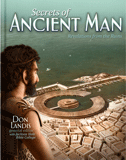
Presence of Ancient Anatomically Modern Humans in Africa
Genomic study suggests the presence of ancient anatomically modern humans all over Africa.
News Source
Evolutionary anthropologists generally believe humans evolved in Africa and spread out from there. They have debated whether modern humans branched from the evolutionary tree in the eastern or southern parts of the continent. Analysis of the genomes of southern African people suggests instead that the modern human genome bears geographic footprints from many parts of the continent. Moreover, the study has identified a genetic variation that may also be associated with a genetic factor related to brow ridges in Neanderthals.
Both the Khoe and the San people are click-speaking tribes and share many traits. Historically the San were hunter-gatherers and the Khoe were herders. The researchers in this study, “Genomic Variation in Seven Khoe-San Groups Reveals Adaptation and Complex African History,” analyzed 2.3 million genetic variations among 220 people from 11 southern African population groups. Seven of these groups were Khoe-San people, and the variations among them formed a pattern that distinguished them from the others.
The Khoe-San genomes also share genetic components with far-distant African tribal groups, such as the east African Maasai, well-known for their cattle-herding. The researchers therefore suggest that east African herders brought their lifestyle and their genes to southern Africa in the distant past.
Evolutionists conventionally date modern humanity’s Out-of-Africa migration at about 60,000 years ago.
Evolutionists conventionally date modern humanity’s Out-of-Africa migration at about 60,000 years ago. The researchers in this study estimate the Khoe-San people diverged from other African populations long before, at about 100,000 years ago. Analysis of the genomic data suggests a later geographic split within this group, the northern and southern branches possessing some differences in the genes affecting the immune system. Based on the great diversity and apparently widespread genetic contributions, the authors conclude, “Both population structure and geographic distribution of genetic variation suggest a complex human population history within Africa.”1 They also say that anatomically modern humans must have already appeared before the Khoe-San people became somehow isolated and diverged from the rest of the African population.2
Anatomically modern humans lack the heavy brow ridges of Neanderthals. Some additional skeletal features of the collarbones and rib cage are also notable distinctions. One of the commonly occurring genetic variants in the Khoe-San people is a gene (RUNX2) known to affect bone and cartilage growth and thought possibly responsible for the unusual skeletal features of Neanderthals.3 Therefore, the researchers keep open the possibility that the African genetic melting pot included archaic humans too.4
So what are we to make of all this? First of all, of course, no molecules-to-man evolution or evidence of ape-like ancestors is in view here. This study is purely concerned with variations among human populations. The huge ages cited (60,000 years and 100,000 years) are based on the usual unverifiable assumptions inherent in molecular clock dating.5
It is of course no surprise to find evidence that human ancestry is complex and intermingled. Even the link to the Neanderthal population, which is associated with Europe and Asia and which left a genetic footprint in our modern genome, is no surprise. All people are descended from Adam and Eve through Noah’s family. When the rebellious people of the post-Flood world dispersed from the Tower of Babel, they were already related. The results are consistent with the biblical history of humanity after the Flood.
Further Reading
- Trace Your Family History through DNA Testing
- Another Variety of Archaic Humans
- Neanderthals vs. Humans: Are They Different?
- When Did Cavemen Live?
- Were Cavemen Real?
- Was the Tower of Babel Dispersion a Real Event?
For More Information: Get Answers
Remember, if you see a news story that might merit some attention, let us know about it! (Note: if the story originates from the Associated Press, FOX News, MSNBC, the New York Times, or another major national media outlet, we will most likely have already heard about it.) And thanks to all of our readers who have submitted great news tips to us. If you didn’t catch all the latest News to Know, why not take a look to see what you’ve missed?
(Please note that links will take you directly to the source. Answers in Genesis is not responsible for content on the websites to which we refer. For more information, please see our Privacy Policy.)
Footnotes
- C. Schlebusch et al., “Genomic Variation in Seven Khoe-San Groups Reveals Adaptation and Complex African History,” Sciencexpress (published early online 20 September 2012). doi: 10.1126/science.1227721
- Ibid.
- In the 2010 study reporting on the Neanderthal genome, researchers noted that RUXN2 was the only gene in the genome known to be associated with the bone and cartilage growth variations which could produce the heavier brow, collarbone, shoulder, and rib cage changes seen in Neanderthal skeletons. From R. E. Green et al., A draft sequence of the Neandertal genome. Science 328, no. 710 (2010). doi:10.1126/science.1188021
- Schlebusch et al., “Genomic Variation.”
- Molecular clock dating assumes that mutation rates over great spans of time can be known and remain constant. The method is based on foundational data that suffers from the statistical mismanagement of error ranges as well as the assumption that one kind of creature in the fossil record evolved into another by accumulating mutations. And circular reasoning is inherent in the calibration of the “clocks” in accord with the radiometric dating methods, giving the appearance of “confirmed” interpretations. See “Researchers Devise Alternate Theory For Cambrian Explosion” and “News to Note, December 31, 2011: Year in Review” for more.
Recommended Resources

Answers in Genesis is an apologetics ministry, dedicated to helping Christians defend their faith and proclaim the good news of Jesus Christ.
- Customer Service 800.778.3390
- © 2024 Answers in Genesis



